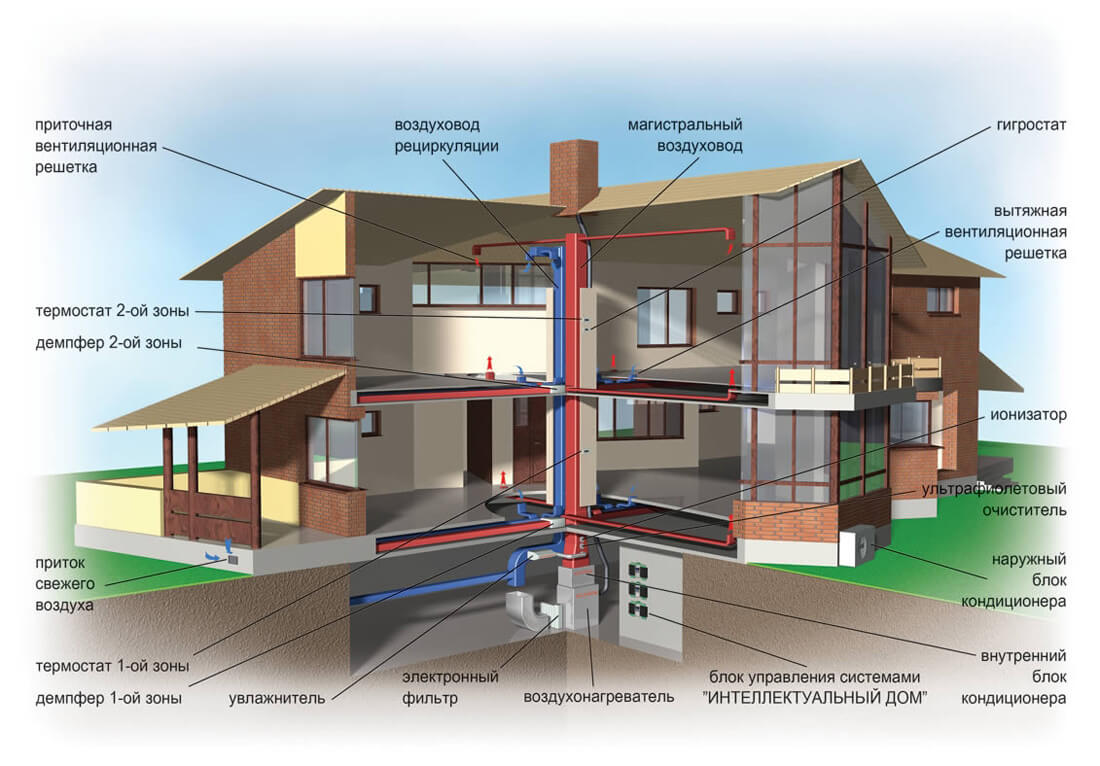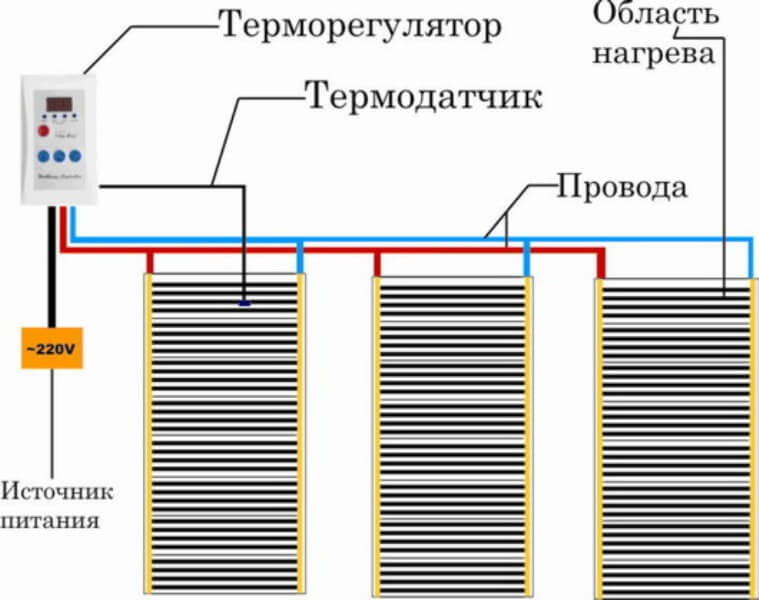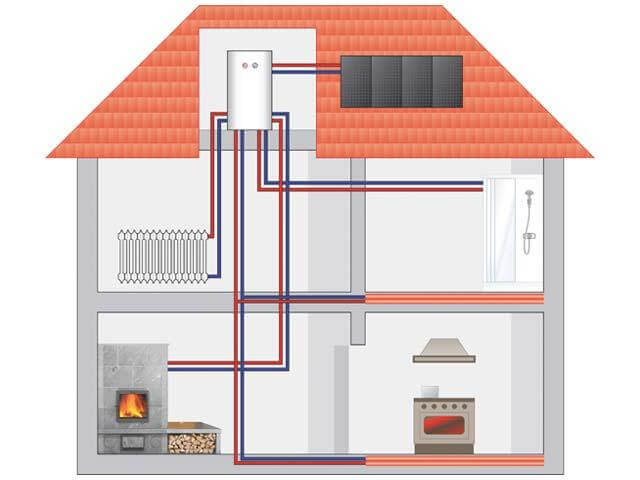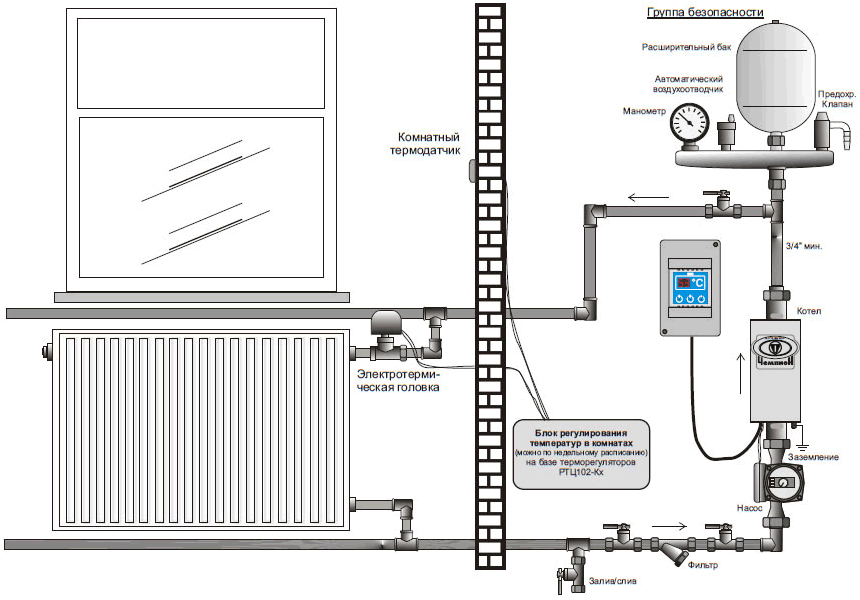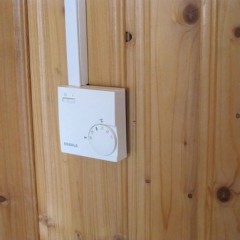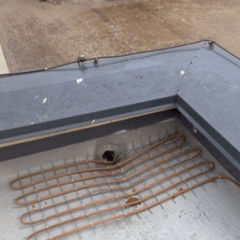How to make heating in a country house?
What systems are there?
So, for starters, consider the heating options for a residential building:
Aerial. It is provided by heat generators that heat the air and fans that distribute heat through the ducts to the heated rooms. Not the best option, because the installation of air heating should be carried out during the construction of a country house. In addition, air heating is not the most economical and also requires constant maintenance (filter cleaning, etc.).
Electric. A good option if the house will be visited rarely, because it will not be necessary to drain the system for the winter or to maintain constant heating so that the heating circuit does not defrost. Installation of electric heating is not difficult if you use electric convectors or infrared heaters. Electric underfloor heating requires proper installation, otherwise the system will not work well or will fail quickly. The main disadvantage of electric heating is the high cost.
Stove. Again, a rational choice for a rare visit to a country house. Heating the housing with a stove is the least comfortable and practical is not automated, which is its main drawback. For the room to be warm, you need the constant presence of a person who will promptly throw firewood or coal into the stove. The main advantages are the low cost of installation and solid fuel.
Water. Well, the most optimal price and quality is the installation of water heating in a country house. Heating is carried out by the boiler (gas, electric or solid fuel), as well as a system of pipes, radiators, convectors (if necessary) and automation (optional). In addition, an underfloor heating system can be installed. This heating option is the most popular and rational, especially if the country house is frequented or is a place of permanent residence.
As for water, I would like to consider in more detail the types of heating options (or rather boilers):
- Electric. Pros: silent operation, safe operation, compact size, multifunctionality. Cons: the quality of the electrical network must be high (voltage drops can damage the equipment), the cost of the electric boiler, as well as the heating costs, are quite high.
- Gas.Among the advantages are low heating costs, relatively inexpensive cost of equipment and at the same time simple operation. The disadvantage is that you need to get permission to install gas equipment.
- Solid fuel. Positive aspects: low cost of the boiler, safety of use, minimum heating costs. The reverse side of the coin is that in order to heat a room, one must constantly monitor the presence of firewood or coal. In addition, solid fuel boilers emit combustion products, which is why it is necessary to mount a chimney.
- Fuel oil. High efficiency (up to 90%), service life reaches 30 years, the ability to automate the system, do not need permissions to install the boiler. However, liquid fuel equipment is quite expensive, in addition, boilers make noise during operation and require placement in a separate room (boiler room).
- Combined. For example, gas-electricity or gas-firewood. With this type of equipment, you will insure your home against freezing in the event of a gas pipeline accident, which is not uncommon in the private sector. However, for convenience you will have to pay more than alternative options.
In addition, I would like to note that water heating can be with natural circulation (the coolant is distributed on the basis of physical laws, as a result of which the system will function even without electricity) and forced (the inclusion of a mains circulation pump in the circuit).
Another important point is the heating circuit diagram, it can be single-pipe (the coolant passes through the radiators in direct sequence) and two-pipe (cold and hot water enter the circuit from different pipes, which makes it possible to more carefully control the room heating temperature).
Installation steps
So that you understand what the installation consists of, for example, we present to your attention the step-by-step process of installing a turnkey heating of a country house:
- calculation and design of the heating system;
- selection of suitable components (including pipe diameter and boiler output);
- purchase of all necessary equipment, delivery to the installation site;
- installation of radiators, boiler, automation;
- laying of main pipes according to the scheme;
- connecting the circuit to the water supply of the house;
- filling the heating system with coolant;
- commissioning of equipment and commissioning of the system.
As you can see, the process of installing a heating system for a country house is quite laborious. If there is no experience in this matter, it is better to overpay a little and use the services of specialists.
Now you know what constitutes a turnkey installation of heating a country house. If you have any questions, ask them in the comments under the article, we will try to help you solve the problem!

